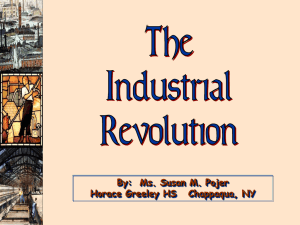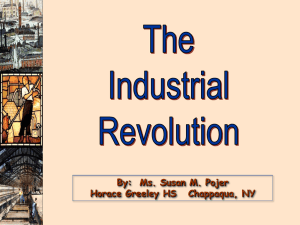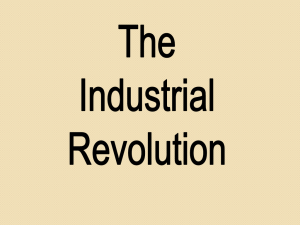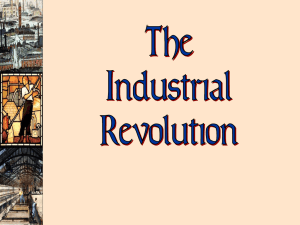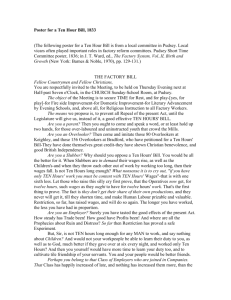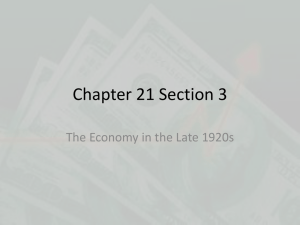Industrial Revolution
advertisement
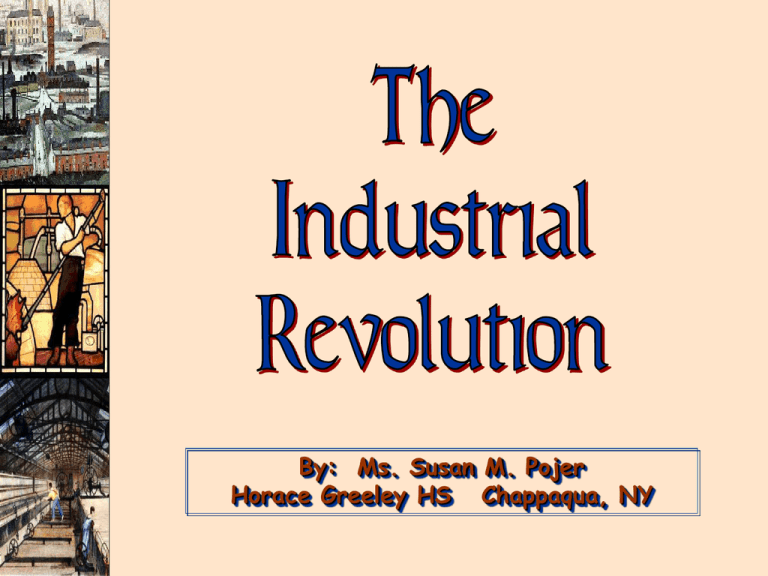
By: Ms. Susan M. Pojer Horace Greeley HS Chappaqua, NY That Nation of Shopkeepers! -- Napoleon Bonaparte The Enclosure Movement “Enclosed” Lands Today Metals, Woolens, & Canals Early Canals Britain’s Earliest Transportation Infrastructure Mine & Forge [1840-1880] ù More powerful than water is coal. ù More powerful than wood is iron. ù Innovations make steel feasible. “Puddling” [1820] – “pig iron.” “Hot blast” [1829] – cheaper, purer steel. Bessemer process [1856] – strong, flexible steel. Coalfields & Industrial Areas Coal Mining in Britain: 1800-1914 1800 1 ton of coal 50, 000 miners 1850 30 tons 200, 000 miners 1880 300 million tons 500, 000 miners 1914 250 million tons 1, 200, 000 miners Young Coal Miners Child Labor in the Mines Child “hurriers” British Pig Iron Production John Kay’s “Flying Shuttle” The Power Loom James Watt’s Steam Engine Richard Arkwright: “Pioneer of the Factory System” The “Water Frame” Jacquard’s Loom Factory Production ) Concentrates production in one place [materials, labor]. ) Located near sources of power [rather than labor or markets]. ) Requires a lot of capital investment [factory, machines, etc.] more than skilled labor. ) Only 10% of English industry in 1850. The Factory System Rigid schedule. 12-14 hour day. Dangerous conditions. Mind-numbing monotony. Textile Factory Workers in England Young “Bobbin-Doffers” Textile Factory Workers in England 1813 2400 looms 150, 000 workers 1833 85, 000 looms 200, 000 workers 1850 224, 000 looms >1 million workers British Coin Portraying a Factory, 1812 Steam Tractor Steam Ship An Early Steam Locomotive Later Locomotives The Impact of the Railroad “The Great Land Serpent” Crystal Palace Exhibition: 1851 Exhibitions of the new industrial utopia. Crystal Palace: Interior Exhibits Crystal Palace: British Ingenuity on Display Crystal Palace: American Pavilion Late 18c: French Economic Advantages V Napoleonic Code. V French communal law. ) ) ) Free contracts Open markets Uniform & clear commercial regulations V Standards weights & measures. V Established technical schools. V The government encouraged & honored inventors & inventions. V Bank of France European model providing a reliable currency. French Economic Disadvantages V Years of war ) ) ) Supported the American Revolution. French Revolution. Early 19c Napoleonic Wars V Heavy debts. V High unemployment soldiers returning from the battlefronts. V French businessmen were afraid to take risks. Factory Wages in Lancashire, 1830 Age of Worker Male Wages Female Wages under 11 2s 3d. 2s. 4d. 11 - 16 4s. 1d. 4s. 3d. 17 - 21 10s. 2d. 7s. 3d. 22 - 26 17s. 2d. 8s. 5d. 27 - 31 20s. 4d. 8s. 7d. 32 - 36 22s. 8d. 8s. 9d. 37 - 41 21s. 7d. 9s. 8d. 42 - 46 20s. 3d. 9s. 3d. 47 - 51 16s. 7d. 8s. 10d. 52 - 56 16s. 4d. 8s. 4d. 57 - 61 13s. 6d. 6s. 4d. Industrial Staffordshire Problems of Polution The Silent Highwayman - 1858 The New Industrial City Early-19c London by Gustave Dore By 1850: Zones of Industrialization on the European Continent ù ù ù ù ù ù Northeast France. Belgium. The Netherlands. Western German states. Northern Italy East Germany Saxony Industrialization By 1850 Railroads on the Continent Share in World Manufacturing Output: 1750-1900 19c Bourgeoisie: The Industrial Nouveau Riche Criticism of the New Bourgeoisie Stereotype of the Factory Owner “Upstairs”/“Downstairs” Life Worker Housing in Manchester Factory Workers at Home Workers Housing in Newcastle Today The Life of the New Urban Poor: A Dickensian Nightmare! Private Charities: Soup Kitchens Private Charities: The “Lady Bountifuls” The Luddites: 1811-1816 Attacks on the “frames” [power looms]. Ned Ludd [a mythical figure supposed to live in Sherwood Forest] The Luddite Triangle The Luddites The Neo-Luddites Today Peterloo Massacre, 1819 British Soldiers Fire on British Workers: Let us die like men, and not be sold like slaves! The Chartists Key Chartist settlements Centres of Chartism Area of plug riots, 1842 The “Peoples’ Charter” V Drafted in 1838 by William Lovett. V Radical campaign for Parliamentary reform of the inequalities created by the Reform Bill of 1832. Votes for all men. Equal electoral districts. Abolition of the requirement that Members of Parliament [MPs] be property owners. Payment for Members of Parliament. Annual general elections. The secret ballot. The Chartists A female Chartist A physical force— Chartists arming for the fight. Adam Smith • The Wealth of Nations (1776) – Invisible Hand – “Mr. Laissez Faire” – Law of Supply and Demand – Law of Competition David Ricardo “Iron Law of Wages.” When wages are high, workers have more children. More children create a large labor surplus that depresses wages. So there is no point in artificially raising wages (through legislation/min. wage laws) Thomas Malthus Population growth will outpace the food supply. War, disease, or famine could control population. The poor should have less children; choosing instead, a higher standard of living Only then will food supply keep up with population. The Utilitarians: Jeremy Bentham & John Stuart Mill The goal of society is the greatest good for the greatest number. There is a role to play for government intervention to provide some social safety net. Jeremy Bentham Principles of Morals and Legislation, 1789 For the most part, government can insure utility (Happiness: most pleasure, least pain) for the greatest number by permitting maximum amount freedom (laissez faire), but there may be times when the pain of the many exceeds the pleasure of the few, then the government must justifiably intervene John Stuart Mill • Principles of Political Economy (1848) – Society must exercise some control over the distribution of wealth – Workers should be free to form labor unions – Government (laws) should restrict child labor – Government (laws) should proect female workers (he even talked about universal suffrage!) – Advocated elementary, state-supported education for all – Advocated income and (confiscatory) inheritance taxes to redistribute wealth Anti-Corn Law League, 1845 4 Expose trade and agriculture to foreign 4 4 4 4 4 4 competition (thus lower prices) Lower price of bread employers could lower wages/ cost of production, thus prices, so British goods more competitive. Give manufactures more outlets for their products (because other nations would follow suit and lift their tariffs on English goods). Thus, would expand employment Make British agriculture more efficient and productive. Promote international peace through trade contact. *1846 Corn Laws were repealed…Why? Government Response k Abolition of slavery in the colonies in (1832) [to raise wages in Britain]. k Sadler Committee (1831) to look into child labor working conditions Factory Act [1833] – child labor. k New Poor Law (1834) – indoor relief. Poor houses; dole. k Reform Bill (1832) – broadened the vote for the middle class in cities. British Reform Bill of 1832 British Reform Bills Some Political Side Effects of Industrialization ù State ownership of some industries. ) RRs Belgium & most of Germany. ù Tariffs ex. British Corn Laws. ù National Banks granted a monopoly on issuing bank notes. ) Bank of England. ) Bank of France. ù Companies required to register with the government & publish annual budgets. ù New legislation to: ) Establish limited liability. ) Create rules for the formation of corporations. ù Postal systems. ù Free trade zones ex. German Zollverein The Socialists: Utopians & Marxists People as a society would operate and own the means of production, not individuals. Their goal was a society that benefited everyone, not just a rich, well-connected few. Tried to build perfect communities [utopias]. Bibliographic Sources ) “Images of the Industrial Revolution.” Mt. Holyoke College. http://www.mtholyoke.edu/courses/rschwart /ind_rev/images/images-ind-era.html ) “The Peel Web: A Web of English History.” http://dspace.dial.pipex.com/mbloy/ceight/primary.htm
